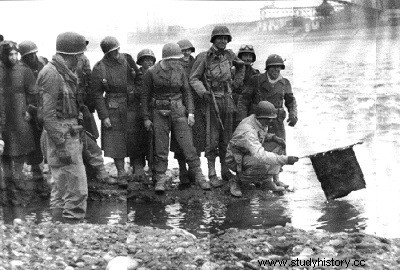
However, writes General de Lattre, if the 2nd C.A. did not have the deserved joy of entering Alsace first, it is to him that it owes its deliverance in part. By annihilating an enemy division, by drawing into the mountains six battalions from the Belfort gap, four taken from the front of the 6th C.A. U.S., seven brought from Germany and a fresh division repatriated from Norway, by concentrating in front of him all the attention and most of the means of the German, he took on the preparation of the victory hard. Without the Battle of the Vosges in October 1944, neither the ride to the Rhine nor the crushing of the Wehrmacht in Belfort and Haute AIsace would have been possible from November.
One could add that if the 2nd C.A. had not drawn all the reserves of the 19th German Army to its side, the audacious irruption into Alsace of General Leclerc's 2nd D.B., crowned by the liberation of Strasbourg, could not have taken place in such favorable conditions, with no German unit left available to oppose it.
Allow me to recall the hardships and sacrifices this battle imposed on the 3rd D.I.A. and to the units attached to it:for three months, this division fought without a day of rest on a front which, from 6 km on October 4, reached more than 100 in December, while its numbers were gradually tripled and that the connections stretched over more than 200 km of snowy and icy roads. Lieutenant-Colonel Lardin, chief of staff of the division, and his officers found themselves, in order to ensure the supply and evacuation of the units, faced with almost insoluble problems, given the means at their disposal. br class='autobr' />As for the troops, they fought from start to finish in inhuman conditions. We fought with the exciting prospect, always disappointed, of entering Alsace first. We fought sparingly with shells and always lacking reinforcements that would have made it possible to immediately exploit the breaches opened in the enemy front. We fought in the rain, then in the snow, with canvas effects, the cloth uniforms of the skirmishers, left in Italy, taking their time to reach them; as for the F.F.I., they most often arrived poorly dressed and shod. We fought and we conquered by attrition, but we ourselves were worn out almost as much as the enemy. By October 18, the 4th R.T.T. was short of 700 men and the goums 1,500. In December, the 7th R.T.A. has 400 men evacuated for frostbite. In four days of the same month, a G.T.M. has 257. Each new leap forward, each counter-attack, tragically lengthens the list of losses. A total of 1,200 3rd D.I.A. and associated units are provisionally interred in Rupt Cemetery. The number of injured and evacuated for frostbite is estimated at four times.
We quantify the losses, but how can we quantify the sum of the physical and moral suffering that marked this slow, this interminable ascent of the Vosges, by the 2nd C.A., by the 3rd D.I.A. above all, escorted by goums and F.F.I.?
In this three-month battle of attrition, the bloodiest of those fought by the 1st Army during its epic, the survivors did not would keep only bitter and painful memories if not opposed by those left to them by the moving welcome of the liberated populations of the Vosges. Nor are they about to forget the indomitable courage of these populations. At the Col de Morbieux, it was our wounded who, through the woods, under the snow, were smuggled back into our lines. In Cornimont, it is the population grouped around its heroic mayor, Mr. Fabre, and his wife, who suffer without flinching the precise fire of mortars, stubbornly refusing to leave their native soil. In Xoulces, it was isolated individuals who, at night, infiltrated through German posts to escape evacuation to the Reich. In Rochesson, it is a resident who comes to inform our gunners of the presence of a German battery near his house, dedicating it to certain destruction. These are just a few examples. Thus, the loyalty and gratitude of the Vosges towards their liberators is matched by their sincere admiration for a population whose patriotism and heroism had already had so often in the past the opportunity to manifest themselves.
Thus a mutual adoption of combatants and civilians took place, not only this familiarity which is established where the troops appear, but a meeting in the highest regions and the most noble of the human heart, those where heroism and devotion stand side by side.
After such an ordeal, it seems almost incredible that our units in which, even after the amalgamation with the F.F.I., will predominate the North African elements, have been able, without taking breath, to take part in the first battle for Colmar, to fly to the aid of Strasbourg, to complete the liberation of Alsace, to force the Siegfried line alongside our American allies, to cross the Rhine, reach the Enz and conquer Stuttgart.. .
War has long been thought to have been the primary creative force in civilization. Recent research at the archaeological site of Caral in Peru challenge this theory. A little over 6,000 years ago, in several places on the planet, man left forests and savannahs to build grandiose cities and monuments
